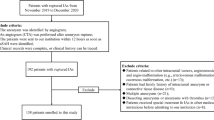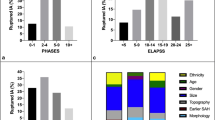Abstract
Previous studies have shown that the growth status of intracranial aneurysms (IAs) predisposes to rupture. This study aimed to construct a nomogram for predicting the growth of small IAs based on geometric and hemodynamic parameters. We retrospectively collected the baseline and follow-up angiographic images (CTA/ MRA) of 96 small untreated saccular IAs, created patient-specific vascular models and performed computational fluid dynamics (CFD) simulations. Geometric and hemodynamic parameters were calculated. A stepwise Cox proportional hazards regression analysis was employed to construct a nomogram. IAs were stratified into low-, intermediate-, and high-risk groups based on the total points from the nomogram. Receiver operating characteristic (ROC) analysis, calibration curves, decision curve analysis (DCA) and Kaplan–Meier curves were evaluated for internal validation. In total, 30 untreated saccular IAs were grown (31.3%; 95%CI 21.8%-40.7%). The PHASES, ELAPSS, and UIATS performed poorly in distinguishing growth status. Hypertension (hazard ratio [HR] 4.26, 95%CI 1.61–11.28; P = 0.004), nonsphericity index (95%CI 4.10–25.26; P = 0.003), max relative residence time (HR 1.01, 95%CI 1.00–1.01; P = 0.032) were independently related to the growth status. A nomogram was constructed with the above predictors and achieved a satisfactory prediction in the validation cohort. The log-rank test showed significant discrimination among the Kaplan–Meier curves of different risk groups in the training and validation cohorts. A nomogram consisting of geometric and hemodynamic parameters presented an accurate prediction for the growth status of small IAs and achieved risk stratification. It showed higher predictive efficacy than the assessment tools.
Graphical Abstract





Similar content being viewed by others
Data availability
The data and materials that support the findings of this study are available on request from the corresponding author, Y. H.
References
Yin Z, Zhang Q, Zhao Y, Lu J, Ge P, Xie H, Wu D, Yu S, Kang S, Zhang Q, Zhang Y, Zhang D, Zhao J, Liu X (2023) Prevalence and procedural risk of intracranial atherosclerotic stenosis coexisting with unruptured intracranial aneurysm. Stroke 54(6):1484–1493
Thompson BG, Brown RD Jr, Amin-Hanjani S, Broderick JP, Cockroft KM, Connolly ES Jr, Duckwiler GR, Harris CC, Howard VJ, Johnston SC, Meyers PM, Molyneux A, Ogilvy CS, Ringer AJ, Torner J (2015) Guidelines for the management of patients with unruptured intracranial aneurysms: a guideline for healthcare professionals from the american heart association/american stroke association. Stroke 46(8):2368–2400
Rutledge C, Jonzzon S, Winkler EA, Raper D, Lawton MT, Abla AA (2020) Small aneurysms with low PHASES scores account for most subarachnoid hemorrhage cases. World Neurosurg 139:e580–e584
van der Kamp LT, Rinkel GJE, Verbaan D, van den Berg R, Vandertop WP, Murayama Y, Ishibashi T, Lindgren A, Koivisto T, Teo M, St George J, Agid R, Radovanovic I, Moroi J, Igase K, van den Wijngaard IR, Rahi M, Rinne J, Kuhmonen J, Boogaarts HD, Wong GKC, Abrigo JM, Morita A, Shiokawa Y, Hackenberg KAM, Etminan N, van der Schaaf IC, Zuithoff NPA, Vergouwen MDI (2021) Risk of rupture after intracranial aneurysm growth. JAMA Neurol 78(10):1228–1235
Liu Q, Leng X, Yang J, Yang Y, Jiang P, Li M, Mo S, Yang S, Wu J, He H, Wang S (2022) Stability of unruptured intracranial aneurysms in the anterior circulation: nomogram models for risk assessment. J Neurosurg. 38:1–10
Doddasomayajula R, Chung BJ, Mut F, Jimenez CM, Hamzei-Sichani F, Putman CM, Cebral JR (2017) Hemodynamic characteristics of ruptured and unruptured multiple aneurysms at mirror and ipsilateral locations. AJNR Am J Neuroradiol 38(12):2301–2307
Burns JD, Huston J 3rd, Layton KF, Piepgras DG, Brown RD Jr (2009) Intracranial aneurysm enlargement on serial magnetic resonance angiography: frequency and risk factors. Stroke 40(2):406–411
Hurford R, Taveira I, Kuker W, Rothwell PM (2021) Prevalence, predictors and prognosis of incidental intracranial aneurysms in patients with suspected TIA and minor stroke: a population-based study and systematic review. J Neurol Neurosurg Psychiatry 92(5):542–548
Backes D, Vergouwen MD, Tiel Groenestege AT, Bor AS, Velthuis BK, Greving JP, Algra A, Wermer MJ, van Walderveen MA, terBrugge KG, Agid R, Rinkel GJ (2015) PHASES Score for Prediction of Intracranial Aneurysm Growth. Stroke 46(5):1221–1226
Cornelissen BMW, Leemans EL, Slump CH, van den Berg R, Marquering HA, Majoie C (2022) Hemodynamic changes after intracranial aneurysm growth. J Neurosurg 136(6):1738–1744
Skodvin T, Johnsen LH, Gjertsen Ø, Isaksen JG, Sorteberg A (2017) Cerebral Aneurysm Morphology Before and After Rupture: Nationwide Case Series of 29 Aneurysms. Stroke 48(4):880–886
Dhar S, Tremmel M, Mocco J, Kim M, Yamamoto J, Siddiqui AH, Hopkins LN, Meng H (2008) Morphology parameters for intracranial aneurysm rupture risk assessment. Neurosurgery 63(2):185–96 (discussion 196–7)
Kashiwazaki D, Kuroda S (2013) Size ratio can highly predict rupture risk in intracranial small (<5 mm) aneurysms. Stroke 44(8):2169–2173
Tutino VM, Yan AJ, Veeturi SS, Patel TR, Rajabzadeh-Oghaz H, Waqas M, Siddiqui AH, Tseng J, Kolega J (2020) Landmark-based shape analysis on middle cerebral intracranial aneurysms: a geometric morphometrics approach to infer natural history. Curr Neurovasc Res 17(5):725–735
Sforza DM, Kono K, Tateshima S, Viñuela F, Putman C, Cebral JR (2016) Hemodynamics in growing and stable cerebral aneurysms. J Neurointerv Surg 8(4):407–412
Cornelissen BMW, Schneiders JJ, Sprengers ME, van den Berg R, van Ooij P, Nederveen AJ, van Bavel E, Vandertop WP, Slump CH, Marquering HA, Majoie C (2018) Aneurysmal parent artery-specific inflow conditions for complete and incomplete circle of willis configurations. AJNR Am J Neuroradiol 39(5):910–915
Jiang P, Liu Q, Wu J, Chen X, Li M, Li Z, Yang S, Guo R, Gao B, Cao Y, Wang S (2018) A novel scoring system for rupture risk stratification of intracranial aneurysms: a hemodynamic and morphological study. Front Neurosci 12:596
Cebral JR, Mut F, Weir J, Putman CM (2011) Association of hemodynamic characteristics and cerebral aneurysm rupture. AJNR Am J Neuroradiol 32(2):264–270
Schneiders JJ, Marquering HA, van Ooij P, van den Berg R, Nederveen AJ, Verbaan D, Vandertop WP, Pourquie M, Rinkel GJ, vanBavel E, Majoie CB (2015) Additional value of intra-aneurysmal hemodynamics in discriminating ruptured versus unruptured intracranial aneurysms. AJNR Am J Neuroradiol 36(10):1920–1926
Greving JP, Wermer MJ, Brown RD Jr, Morita A, Juvela S, Yonekura M, Ishibashi T, Torner JC, Nakayama T, Rinkel GJ, Algra A (2014) Development of the PHASES score for prediction of risk of rupture of intracranial aneurysms: a pooled analysis of six prospective cohort studies. The Lancet Neurology 13(1):59–66
Backes D, Rinkel GJE, Greving JP, Velthuis BK, Murayama Y, Takao H, Ishibashi T, Igase M, terBrugge KG, Agid R, Jääskeläinen JE, Lindgren AE, Koivisto T, von Und Zu, Fraunberg M, Matsubara S, Moroi J, Wong GKC, Abrigo JM, Igase K, Matsumoto K, Wermer MJH, van Walderveen MAA, Algra A, Vergouwen MDI (2017) ELAPSS score for prediction of risk of growth of unruptured intracranial aneurysms. Neurology 88(17):1600–1606
Etminan N, Brown RD Jr, Beseoglu K, Juvela S, Raymond J, Morita A, Torner JC, Derdeyn CP, Raabe A, Mocco J, Korja M, Abdulazim A, Amin-Hanjani S, Al-Shahi Salman R, Barrow DL, Bederson J, Bonafe A, Dumont AS, Fiorella DJ, Gruber A, Hankey GJ, Hasan DM, Hoh BL, Jabbour P, Kasuya H, Kelly ME, Kirkpatrick PJ, Knuckey N, Koivisto T, Krings T, Lawton MT, Marotta TR, Mayer SA, Mee E, Pereira VM, Molyneux A, Morgan MK, Mori K, Murayama Y, Nagahiro S, Nakayama N, Niemelä M, Ogilvy CS, Pierot L, Rabinstein AA, Roos YB, Rinne J, Rosenwasser RH, Ronkainen A, Schaller K, Seifert V, Solomon RA, Spears J, Steiger HJ, Vergouwen MD, Wanke I, Wermer MJ, Wong GK, Wong JH, Zipfel GJ, Connolly ES Jr, Steinmetz H, Lanzino G, Pasqualin A, Rüfenacht D, Vajkoczy P, McDougall C, Hänggi D, LeRoux P, Rinkel GJ, Macdonald RL (2015) The unruptured intracranial aneurysm treatment score: a multidisciplinary consensus. Neurology 85(10):881–889
Brinjikji W, Pereira VM, Khumtong R, Kostensky A, Tymianski M, Krings T, Radovanovich I (2018) PHASES and ELAPSS scores are associated with aneurysm growth: a study of 431 unruptured intracranial aneurysms. World Neurosurg 114:e425–e432
Lindgren AE, Kurki MI, Riihinen A, Koivisto T, Ronkainen A, Rinne J, Hernesniemi J, Eriksson JG, Jääskeläinen JE, VonundzuFraunberg M (2014) Hypertension predisposes to the formation of saccular intracranial aneurysms in 467 unruptured and 1053 ruptured patients in Eastern Finland. Ann Med 46(3):169–76
Jiang K, He T, Ji Y, Zhu T, Jiang E (2023) The perspective of hypertension and salt intake in Chinese population. Front Public Health 11:1125608
Wang C, Liu TB, Mu L, Wang M, Li Y, Yao SY, Zhao MX, Xue H (2020) Association between dietary sodium intake and blood pressure variability in Chinese patients with hypertension. Chin Med J (Engl) 133(9):1066–1072
Yang H, Cho KC, Kim JJ, Kim YB, Oh JH (2022) New morphological parameter for intracranial aneurysms and rupture risk prediction based on artificial neural networks. J Neurointerv Surg 15:e209
Texakalidis P, Sweid A, Mouchtouris N, Peterson EC, Sioka C, Rangel-Castilla L, Reavey-Cantwell J, Jabbour P (2019) Aneurysm formation growth, and rupture: the biology and physics of cerebral aneurysms. World Neurosurg 130:277–284
Mutlu O, Salman HE, Al-Thani H, El-Menyar A, Qidwai UA, Yalcin HC (2023) How does hemodynamics affect rupture tissue mechanics in abdominal aortic aneurysm: Focus on wall shear stress derived parameters, time-averaged wall shear stress, oscillatory shear index, endothelial cell activation potential, and relative residence time. Comput Biol Med 154:106609
Veeturi SS, Patel TR, Baig AA, Chien A, Monteiro A, Waqas M, Snyder KV, Siddiqui AH, Tutino VM (2022) Hemodynamic analysis shows high wall shear stress is associated with intraoperatively observed thin wall regions of intracranial aneurysms. J Cardiovasc Dev Dis 9(12):424
Meng H, Tutino VM, Xiang J, Siddiqui A (2014) High WSS or low WSS? Complex interactions of hemodynamics with intracranial aneurysm initiation, growth, and rupture: toward a unifying hypothesis. AJNR Am J Neuroradiol 35(7):1254–62
Acknowledgements
We thank Prof. An and team members for technical assistance with the computational fluid dynamics simulations. The authors declared no potential conflicts of interest with respect to the research, authorship, and/or publication of this article.
Funding
This project was supported by the Tianjin Science and Technology Program (Grant No. 20JCZDJC00620) and Tianjin Jinnan Science and Technology Program (Grant No. 20230108).
Author information
Authors and Affiliations
Contributions
YY, XA: Conceptualization, Methodology, Writing—Original Draft. HR, BL, SJ, LL: Formal analysis, Data Curation, Validation. YY, YD, TL: Software, Investigation. XA, YH: Supervision, Writing—Review & Editing, Project administration. All authors approved the final version of the manuscript.
Corresponding author
Ethics declarations
Competing interests
The authors declare no competing interests.
Ethical approval
The study was conducted according to the guidelines of the Declaration of Helsinki, and approved by the Institutional Review Board of the Tianjin Huanhu Hospital (No. 2020–34, 8/10/2020). Written informed consent for participation was not required for this study in accordance with the national legislation and the institutional requirements.
Additional information
Publisher's Note
Springer Nature remains neutral with regard to jurisdictional claims in published maps and institutional affiliations.
Yujia Yan, Xingwei An have contributed equally to this work and share first authorship.
Supplementary Information
Below is the link to the electronic supplementary material.
Rights and permissions
Springer Nature or its licensor (e.g. a society or other partner) holds exclusive rights to this article under a publishing agreement with the author(s) or other rightsholder(s); author self-archiving of the accepted manuscript version of this article is solely governed by the terms of such publishing agreement and applicable law.
About this article
Cite this article
Yan, Y., An, X., Ren, H. et al. Nomogram-based geometric and hemodynamic parameters for predicting the growth of small untreated intracranial aneurysms. Neurosurg Rev 47, 169 (2024). https://doi.org/10.1007/s10143-024-02408-x
Received:
Revised:
Accepted:
Published:
DOI: https://doi.org/10.1007/s10143-024-02408-x




